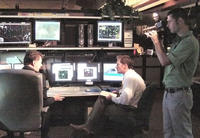-
The Transboundary Agreement is not just about the cost of gas and the environment
The Transboundary Agreement, which the United States and Mexico reached on 20 February, regulates oil and gas development in the Gulf of Mexico; before the agreement is ratified, there is a need to address serious security issues related to building more oil rigs in the Gulf – for example, the fact that the Mexican government cannot control its powerful criminal organizations, and that it will be easy for terrorists in a small boat to overrun one of these deepwater rigs
-
-
Electricity from trees
Plants have long been known as the lungs of the earth, but a new finding has found they may also play a role in electrifying the atmosphere; scientists found the positive and negative ion concentrations in the air were twice as high in heavily wooded areas than in open grassy areas, such as parks
-
-
Confirmed: oil from Deepwater Horizon disaster entered food chain
For months, crude oil gushed into the water at a rate of approximately 53,000 barrels per day; new study confirms that not only did oil affect the ecosystem in the Gulf during the blowout, but it was still entering the food web after the well was capped
-
-
Asteroid to miss Earth next year, but not by much

When it whizzes past Earth in 2013, a newly discovered asteroid is going to miss our planet — but not by much; the 50-meter space rock is expected to come closer than many satellites, highlighting the growing need to keep watch on hazards from above
-
-
Good news: metal-reducing bacteria interacts with plutonium oxide
Studies show that under oxygen-free conditions, plutonium(IV) hydrous oxide, the most common subsurface form of plutonium, does not become very soluble; this information will help in developing effective approaches for isolating and removing the contaminants before they can impact humans and the environment
-
-
Iron is key to reversing climate change
Scientists and politicians are trying to devise ways to reduce CO2 emissions — but when it comes to getting rid of the CO2 that is already there, nature itself plays an important role: carbon dioxide is removed from the atmosphere and safely trapped on the ocean floor through a natural reaction that fixes the molecule to organic carbon on the surface of large bodies of water
-
-
Millions of Americans at risk of flooding as sea levels rise
Nearly four million Americans, residing in a combined area larger than the state of Maryland, find themselves at risk of severe flooding as sea levels rise in the coming century, new research suggests; in terms of population, Florida is the most vulnerable, closely followed by Louisiana, California, New York, and New Jersey
-
-
iPads allow judges to sign warrants anywhere
Getting local judges to sign last minute warrants just got a lot easier with iPads
-
-
Molecule may aid nuclear waste clean-up
Scientists have produced a previously unseen uranium molecule in a move that could improve clean-up of nuclear waste
-
-
High manganese levels making air breathing dangerous in some areas
In residential neighborhoods near manufacturing industries, a breath of air may be more hazardous than refreshing; research finds manganese concentrations higher in residential neighborhoods than industrial sites, levels vary by region
-
-
If Japan-like disaster happened in U.S., results would be far worse
An estimated 20,000 people died or are still missing after a massive earthquake-induced tsunami struck Japan on 11 March 2011, yet some 200,000 people were in the inundation zone at the time; experts say that if the same magnitude earthquake and tsunami hits the Pacific Northwest, the death toll will be much higher because of the lack of comparable preparation; that 90 percent rate could be the number of victims, not survivors
-
-
Industry: current chemical safety standards sufficient, should be extended
DHS’s management of the U.S. chemical plant safety has come under criticism lately, but he Society of Chemical Manufactures and Affiliates (SOCMA) said it strongly supports U.S. chemical security standards; the industry associated noted that since the program’s 2007 launch, more than 2,000 facilities have changed processes or inventories such that they are no longer considered high-risk under the Chemical Facility Anti-Terrorism Standards (CFATS)
-
-
Better to use spray rather than a gun in bear encounters
Carrying a gun in bear country does not mean you are more protected in the event of a bear encounter; researchers say people should behave cautiously and carry bear spray instead
-
-
National Weather Service budget cuts threaten poor IT infrastructure

The Obama administration has proposed cutting more than $39 million from the National Weather Service’s (NWS) budget, particularly from its IT department, and critics worry that the cuts could cause the agency’s already crippling infrastructure problems to grow worse
-
-
Increase in groundwater demands due to climate change
As precipitation becomes less frequent due to climate change, lake and reservoir levels will drop and people will increasingly turn to groundwater for agricultural, industrial, and drinking water needs; the resource accounts for nearly half of all drinking water worldwide, but recharges at a much slower rate than aboveground water sources and in many cases is nonrenewable
-
- All
- Regional
- Water
- Biometrics
- Borders/Immig
- Business
- Cybersecurity
- Detection
- Disasters
- Government
- Infrastructure
- International
- Public health
- Public Safety
- Communication interoperabillity
- Emergency services
- Emergency medical services
- Fire
- First response
- IEDs
- Law Enforcement
- Law Enforcement Technology
- Military technology
- Nonlethal weapons
- Nuclear weapons
- Personal protection equipment
- Police
- Notification /alert systems
- Situational awareness
- Weapons systems
- Sci-Tech
- Sector Reports
- Surveillance
- Transportation
Advertising & Marketing: advertise@newswirepubs.com
Editorial: editor@newswirepubs.com
General: info@newswirepubs.com
2010-2011 © News Wire Publications, LLC News Wire Publications, LLC
220 Old Country Road | Suite 200 | Mineola | New York | 11501
Permissions and Policies
Editorial: editor@newswirepubs.com
General: info@newswirepubs.com
2010-2011 © News Wire Publications, LLC News Wire Publications, LLC
220 Old Country Road | Suite 200 | Mineola | New York | 11501
Permissions and Policies
